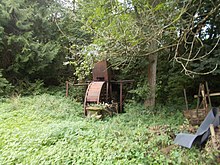Adventurer's hut
The Abentheuerer Hütte is a former ironworks in the Rhineland-Palatinate municipality of Abentheuer in Germany .
The beginnings
The Abentheuerer Hütte, built in 1499, is considered the oldest verifiable blast furnace operation in the Hunsrück . The founders of the plant were the master Hans Eisenschmidt from Eisenschmitt near Himmerod and his son Matthäus. The technical knowledge was only slightly further developed in the period that followed. In 1567 the blacksmith Meister Paulus, who immigrated from Schleiden, is mentioned on “the” adventure.
Early modern age
In 1605 the Wickenroden pastor Friedrich Hellbach wrote: "There are ironworkers around Birkenfeld [= adventure], where they make the most beautiful iron stoves and all kinds of vessels [pots] that are seduced in other countries [...]." The Eisenschmidt family was one of the pioneers of the iron and steel industry in the Hunsrück. In 1621 Johann and Nikolaus Eisenschmidt are mentioned.
The Thirty Years War brought operations to a standstill. 1635 died with Johann Eisenschmidt d. J. the last owner of the adventure hut at the Pest for the time being . In the same year the plant was destroyed. The same thing happened at the plants in Damflos , Nonnweiler and Züsch .
The reconstruction was carried out by entrepreneurs from Wallonia . In 1672 Jean Hujet restarted the iron hammer of the adventurer's hut. In 1699, Remacle de Hauzeur (1663–1745) took over the iron and steel works and made it the headquarters of his various companies in the western and central Hunsrück. He was allowed to burn charcoal in the stately forests as needed. In addition, he was granted the sole right to extract minerals of all kinds in the Birkenfeld office; for this he had to pay tithes to the local government. In 1701 he received permission to build a blast furnace .
In 1763 Johann Heinrich Stumm (1709–1783) from Asbach acquired the Abentheuerer Hütte for an amount of 19,000 guilders . In addition to the residential and farm buildings, the following are listed on buildings: the large hammer, the small hammer, the iron cutter, the arbiter and the iron magazine. In 1765 a blast furnace was built. The rights for ore extraction were transferred to Stumm. After Stumm's death, the steelworks passed to his four sons.
19th century
In the years 1800–1815 the steelworks had to struggle with great difficulties. There were complaints about high taxes, high timber prices and exhausted ore mines. Many ironworks had sprung up in western Germany, and adventure was no longer competitive.
In 1806 the Stumm brothers made the leap to the Saar and acquired the Neunkirchener Hütte . In 1809 the Brebacher Hütte and the Fischbacher Schmelze near Quiigart were added. The decisive factor had been the iron stone deposits there, which promised a better quality pig iron than in the Hunsrück, but also the more favorable traffic situation. In 1807 Friedrich Philipp Stumm (1751–1835) moved from Abentheuer to Saarbrücken .
Conditions improved when the Principality of Birkenfeld was established as part of the Grand Duchy of Oldenburg in 1817 .
A granddaughter of Johann Heinrich Stumm married Oberbergrat Heinrich Böcking . In 1839 the Böcking family came into possession of the hut. At that time the plant was composed as follows: 1 blast furnace, 1 large and a small hammer, 1 large polishing drum, 1 cinder block, 1 sand mill, 1 cleaning house, 1 storage room for wrought iron and 1 warehouse for finished goods. The mighty iron blocks, which were mostly obtained from outside and called pigs, were processed on the big hammer. The large polishing drum, popularly called Rumpel because of the deafening noise it made, was used to polish the shrapnel balls.
Opposite the rumble was the slag pound, which knocked the blast furnace slag into the sand of the wall and the road with no less loud rumbling. The sand mill provided the fine sand that the shapers used. The cat was a strange institution . It was used to crush the thick iron blocks and consisted of three pyramid-shaped strong beams, at the crossing point of which a pulley was attached, with the help of which a huge iron ball was raised. Now you put an iron block underneath and let the ball fall on it. In the cleaning house, the finished goods were cleaned with wire brushes and files.
The Böcking brothers obtained their ore from the Schwarzenbach , Reichenbach and Buhlenberg mines . In front of Buhlenberg, a funnel-shaped hole in a meadow reveals where the shaft used to lead into the depths. About 200 workers were employed at the smelter in the 1860s. In the further heyday from 1848 to 1871, ammunition was especially produced.
In quieter times, wagon axles, stoves, ornate stove decorations, pots of all kinds, dainty smoking tables with services, etc. were made for export all over the world.
After 1870 operations were more and more restricted as a result of the transition from charcoal to coke blast furnace operation and from fresh fire to puddle furnace operation , and production was discontinued in 1875. The owners moved to the Halbergerhütte .
Todays situation
Today the hut is still owned by the Böcking family, descendants of the Stumm family. The site is privately owned and is only accessible as part of guided tours and on Monument Open Day .
literature
- Hermann-Josef Braun: The ironworks of the Hunsrück: 15th to the end of the 18th century (= Trier historical research, 17). Verlag Trier Historical Research, Trier 1991, ISBN 3-923087-16-0 .
Web links
- Caspar Kampf: Ironworks adventure.
- Contributions to the history of the adventurous ironworks. In: abentheuer-online.de. Archived from the original on March 24, 2008 .
- Archives of the owner families Stumm and Böcking in the state main archive Koblenz
- Friederike Bär, Nicole Etzkorn, Manuel Schellhas, Jörn Schultheiß, Peter Burggraaff: Adventurer Hut. In: KuLaDig, Kultur.Landschaft.Digital. Rhineland Regional Council , 2016 .
Coordinates: 49 ° 39 '13.79 " N , 7 ° 5' 58.63" E



